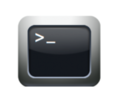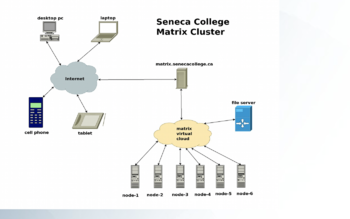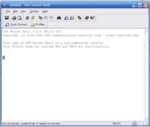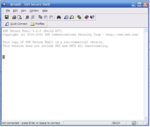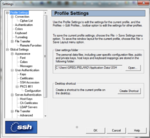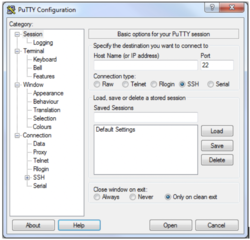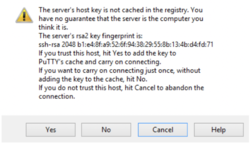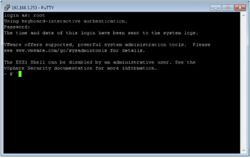Tutorial 1: Using Your Matrix Server Account
Contents
LEARNING ABOUT YOUR MATRIX SERVER ACCOUNT
Main Objectives of this Practice Tutorial
- Understand the purpose of the Matrix server and the advantage of combining Linux servers to form a cluster.
- List the steps to connect to your Matrix server account in the computer labs at Seneca College.
- List the steps to connect to your Matrix server account from a computer outside of Seneca College.
- Learn to Effectively Use the Command Prompt (Linux shell)
- Change your Matrix Account Password
- Exit your Matrix Linux Account
- Perform Review Questions for Additional Linux Course Practice
- Perform Review Questions for Additional Linux Course Practice
Tutorial Resources
| Course Notes / Software |
Linux Command/Shortcut Reference |
YouTube Videos | ||
| Course Notes:Tutorials:Windows SSH client Software:
|
Logging Out of Matrix Server
Shell Command Line Editing |
General Linux Commands
|
Brauer Instructional Videos: | |
Purpose of Having a Matrix Account
While attending Seneca College, you will be using many different computer systems to perform various operations. Some of these servers include:
| my.senecacollege.ca | Learning Content Management System (Student Grades / Notes / Online Quizzes) |
| ict.senecacollege.ca | Main ICT Webserver |
| wiki.cdot.senecacollege.ca | Course WIKIs for Seneca College Students |
| matrix.senecacollege.ca | Linux Account for Student Practice and Assignment submission |
Although you need to study concepts throughout this course, you will also need to learn to issue and memorize simple as well as more advanced Linux commands. This requires that you practice issuing Linux commands on a frequent basis to become more comfortable when working the Unix and Linux command-line environments.
Just like with other operating systems like MS Windows, it is important to learn how to open a command prompt in order to issue Linux commands to perform common Linux OS tasks. In Unix/Linux, a shell is simply an interface / interpreter to allow a user to communicate with the Linux computer system (server). Linux shells have evolved (improved) over a period of time. You will be using the Bash Shell which is considered to be user-friendly.
Layout of the Matrix Server
The Matrix server consists of several Virtual Computers connected together to form a cluster. A cluster is a cost effective alternative to buying larger servers.
All registered students in this course have access to an account on the Matrix server. You will be using this account for the following reasons:
- Issuing Linux commands
- Becoming productive using the Linux command prompt (shell)
- Performing Linux Practice Tutorials
- Performing Linux Assignments (3)
- Practice Issuing Linux Command Review Questions
In the next section, you will learn how to connect to and login to your Matrix server account both at a college lab workstation and from a remote computer such as your home computer or your laptop computer.
INVESTIGATION 1: ACCESSING YOUR MATRIX LINUX ACCOUNT
In this section, you will learn how to access your Matrix Linux account by two different methods:
- From a workstation within a Seneca College lab
- From your own computer within or outside Seneca College
Part 1: Access your Matrix Account from a Seneca College Lab
You will learn how to connect to your Matrix Linux account from a workstation in your computer labs at Seneca college.
This would be useful if you do not have a notebook computer and are required to use one of the workstations available in your Seneca computer lab.
MyApps (AppsAnywhere) is an application streaming service that lets you install software on any Seneca PC on demand. Any software application on the MyApps menu can be used on computers in classrooms, labs, and the Computing Commons.
Reference: https://inside.senecacollege.ca/its/software/myapps/
You will now use MyApps on your Windows workstation in your Seneca lab room to launch an application
to allow you to connect and login to your Matrix server account.
Perform the Following Steps:
- Start your workstation in your lab and login to your Seneca Windows account.
- Make certain that the MyApps window is open. This window should have opened shortly after you logged into your Windows workstation. If the application windows is not open, click on the MyApps icon on the desktop to launch).
- Click on the Search Apps area located in the top right corner of the MyApps window and type the word: ssh
- Several SSH applications will appear.
NOTE: All of these applications allow you to connect to your Matrix account.
We will use the application called SSH Secure Shell Client for this practice tutorial. - Double-click on the SSH Secure Shell Client application icon to launch this program.
- The main SSH Client window will appear. Click on the Quick Connect button.
NOTE: The Connect dialog box allows the user to specify the server name and your account name
to allow you to connect to the server. - Click on the textbox labelled Hostnanme and enter the text: matrix
NOTE: You can use the hostname matrix since you are located inside Seneca's network.
If you where located outside Seneca's network, then you would need to enter the full domain name: matrix.senecac.on.ca - When connecting securely for the first time, a dialog box will appear to share a "public key" with your Matrix account in order to make your interaction between your workstation and the remote Linux server secure within the network (i.e. encrypted to prevent unauthorized access by other users)
FYI: To make communications over a network secure, a computer generates two keys: a private key that is kept on the computer, and a public key, which can be shared with other computers. Transmissions from your computer uses the private key to encrypt (scramble) transmission to the remote computer, which in turn, uses the public key to decrypt (unscramble) the transmission. Likewise, the remote computer uses the public key to encrypt (scramble) transmissions and your computer uses the private key to decrypt (unscramble) those transmissions. - Click the Yes button to share your public key.
- Next, a dialog box will appear prompting you for your Matrix account password in order to gain entry to your Matrix account. Your Matrix password is identical to your Seneca password. As you type the password, the text will be blocked-out or hidden to prevent others from viewing the screen to obtain your password
- Enter your password and click OK or press ENTER
- Click OK or press ENTER at the second Authentication Response dialog box.
NOTE: If you encounter an error message, this can occur for several reasons:- You mis-spelled the name of the server
- You mis-spelled your Matrix username (same username that you connect to my.senecacollege.ca)
- You mis-spelled your password (same password that you connect to my.senecacollege.ca)
If you encountered an error logging in, issue the same steps to connect to your Matrix account,
but carefully check your server name, username and your password. If you continue to experience the same problems,
you can go to the computer help desk in the learning commons to get help. - If you entered your password correctly, the main SSH Linux shell should appear where you enter Linux commands.
The Matrix server has been configured to allow users to only interact with the Linux OS by issuing commands. There are various reasons for this, but the main 2 reasons are to force students to learn how to issue Linux commands as well as limitations to remote access to a graphical Linux server due to large number of users (students).
Later in the course, your instructor may demonstrate other ways of accessing graphical versions of Linux, and how to launch a shell terminal.
You can configure the SSH application to adjust elements such as the window size and text font type and text font size. We will be showing you how to configure your SSH Secure Shell Client, but the other applications can allow you to configure their settings.
Perform the Following Steps:
- Click on the Edit menu item, and then select Settings in the Edit drop-down menu.
- To change the size of your shell window, under the Global Settings section, click Appearance
- Change the window size both horizontal and vertical to larger values.
- To change the font size, under the Global Settings section, click Font
- Select a larger font size and click OK
- You now should notice that you have customized your SSH shell terminal. You can use the settings screen to also change your background and text colours if you are interested in doing so.
- To exit your Matrix session, type the following command and press ENTER: exit
NOTE: You should notice that the colour of the text changes slightly when disconnected and you are unable to issue Linux commands from that window. - After you have disconnected from your account, then close the SSH Secure Shell Client application window.
- It is recommended to repeat these steps with connecting to your Matrix account from a Seneca lab workstation until you become comfortable with the process.
In the next section, you will learn how to connect to your Matrix server account from a different computer (for example: your laptop computer at Seneca College or your computer at home). In that section, we will introduce you to the other SSH application called "Putty".
Part 2: Access your Matrix Account From your own computer within or outside the Seneca College Network
You will learn how to connect to your Matrix Linux account from your own computer whether it be a laptop computer or your home computer.
This would be useful if you want to access your Matrix Linux account on your own computer to practice Linux commands or perform your assignment outside of the scheduled class-time.
We will be learning to use a different SSH application called "Putty". In this way, then you can decide which SSH application you would like to use for the remainder of this course.
- Perform the following steps:
- Click on the following link to download the Putty executable file:
http://the.earth.li/~sgtatham/putty/latest/x86/putty.exe
NOTE: If you are interested in downloading and installing other SSH applications (including the
SSH Secure Shell Client application used in part 1), refer to week 1 links in the ULI101 Weekly Schedule. - The putty executable file does not install the Putty program. To run this program, open a file manager, move to the Downloads directory and double-click on the putty.exe file.
- The Putty configuration window will appear.
You can configure the SSH application to adjust elements such as the window size and text font type and text font size. We will be showing you how to configure your SSH Secure Shell Client, but the other applications can allow you to configure their settings. - To change the size of your shell window, click Window
- Change the rows and columns to larger values.
- To change the font size, under the Window section, click Appearance
- In the left window under Font Settings, click the Change button.
- Select a larger font size and click Apply
- You will return to the Putty Configuration window.
- To login to your Matrix Linux account, click on Sessions
- In the Host Name sectionand enter the text: matrix
NOTE: You can use the hostname matrix since you are located inside Seneca's network.
If you where located outside Seneca's network, then you would need to enter the full domain name: matrix.senecac.on.ca - Click on the Open button and the Putty session window should appear.
- Enter your username when prompted.
- Enter your password when prompted.
- When connecting securely from the putty application for the first time, a dialog box will appear to share a "public key" with your Matrix account in order to make your interaction between your workstation and the remote Linux server secure within the network (i.e. encrypted to prevent unauthorized access by other users)
- Click the Yes button to share your public key.
NOTE: If you encounter an error message, this can occur for several reasons:- You mis-spelled the name of the server
- You mis-spelled your Matrix username (same username that you connect to my.senecacollege.ca)
- You mis-spelled your password (same password that you connect to my.senecacollege.ca)
If you encountered an error logging in, issue the same steps to connect to your Matrix account,
but carefully check your server name, username and your password. If you continue to experience the same problems,
you can go to the computer help desk in the learning commons to get help. - If you followed the login sequence correctly, the Putty Shell window will appear where you can issue Linux commands.
- To exit your Matrix session, type the following command and press ENTER: exit
NOTE: You should notice that the Putty application window will disappear. - After you have disconnected from your account, then close the SSH Secure Shell Client application window.
- It is recommended to repeat these steps with connecting to your Matrix account from a Seneca lab workstation until you become comfortable with the process.
In the next investigation, you will learn how to issue Linux commands and how to setup and perform the first two sections of the online ULI101 assignment #1.
INVESTIGATION 2: USING THE LINUX SHELL / ONLINE ASSIGNMENTS
In this section, you will learn how to use the Linux Shell. Topics in the section include:
- Learn Basic Shell Editing and Linux command structure (arguments and options)
- Learn several general Linux commands
- Learn how to perform online assignments
Part 1: Using the Linux Shell
x
Bash Shell Shortcut Keys
Learning shortcut keys in any OS terminal will allow you to be more productive as a sysadmin. You will focus on learning a few common Bash Shell keyboard shortcut keys and learn where you can access online help for additional shortcuts (if required).
Perform the Following Steps:
- Type the following Linux command, but DON’T press the ENTER key: cd /bin
- Press the ctrl-a key combination. What happens?
- Press the alt-shift-f key combination. What happens?
- Press the ctrl-w shortcut. What happens?
- Type the following command: ls
- Press the ctrl-e key combination and press ENTER. What was the purpose of using these key combinations?
Getting Help with Linux Commands
With the Linux OS containing over 2500 commands and utilities, it is good for a Linux user or sysadmin to learn about how to use commands “on-the-fly”.
You should have learned that the man command can provide information on how to use a command (i.e. usage, arguments, options). The commands are classified into sections or “volumes”.
12. Issue the following command: man man
How many volume numbers are contains in the man pages? (like executable programs or games)?
13. In the right-hand textbox, write the purpose for volumes 1, 3, and 8 for the man command.
14. Issue the following pipeline command: man -k copy | grep 8
What was the purpose of issuing the pipeline command displayed above?
15. If you wish to change your password, you can change it by issuing the command: passwd
What option for the passwd command can be used to change user info (such as name)? Hint: use the manpages for the passwd command.
You are NOT required to change your password for this tutorial.
- Perform the following steps:
- x
Part 2: Performing Online Assignments
x
- Perform the following steps:
- x
LINUX PRACTICE QUESTIONS
The purpose of this section is to obtain extra practice to help with your assignment #1, quizzes, your midterm, and your final ezam.
Here is a link to the MS Word Document of ALL of the questions displayed below but with extra room to answer on the document to simulate a quiz:
https://ict.senecacollege.ca/~murray.saul/uli101/uli101_week1_practice.docx
Your instructor may take-up these questions during class. It is up to the student to attend classes in order to obtain the answers to the following questions. Your instructor will NOT provide these answers in any other form (eg. e-mail, etc).
Review Questions:
- What is a “Linux Cluster”? What is an advantage of using a Linux cluster?
- List three unique server names at Seneca college and briefly explain the purpose of that server.
- List the steps to connect and login to your Matrix Linux server account from a workstation in a computer lab at Seneca College.
- List the steps to connect and login to your Matrix Seneca College account on your home computer.
- List 3 unique ways to log-out of your Matrix account (not including closing the SSH window or application).
- List the steps to change your Matrix password.
- What is the difference between a Linux command and an argument?
- What is the purpose of a command option?
- What character(s) can separation between commands and arguments?
